
The wildness of Tarangire National Park disappeared as soon as we left the park. We were still in a rural environment, but one where every bit of open ground was being intensively grazed. There was only one substantial town between Tarangire park and the Nou Forest, where we were headed, so we stopped there to fuel up and get a few supplies. Douglas had told me the Rover only had a couple of modifications -- the addition of the snorkel (more about that later), and the addition of another fuel tank. We filled up both tanks, as it would be quite a while before we hit another station.
It was market day in Babati, and everyone was out selling and shopping.
Our needed supplies consisted of two pretty simple things -- some large nails / spikes, and a small bag of salt. Douglas explained they were things the Hadza people, who we would be visiting later, needed.
 |
| Babati Market |
 |
| Babati Market |
Whenever we were heading down a road, we saw people walking or riding bicycles. The vast majority of them were doing one of three things -- hauling water, hauling feed (grass) for cattle, or hauling firewood.
 |
| Firewood Bicycles |
We were headed for the Nou Forest, through an agricultural area to visit people who were working to conserve the forest habitat. Our visit coincided with the short dry season between the "short rains" and the "long rains". It had rained some during the short rains before we arrived, and things were greening up. It was great to see the land and crops doing well as a result of the rains; but it was sad to see the results of overgrazing from the population pressure.
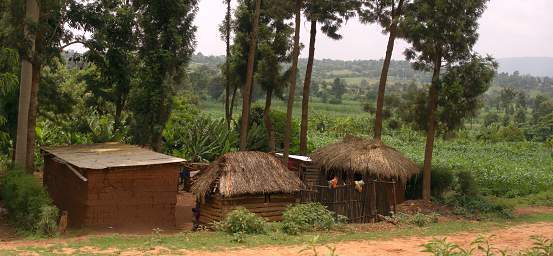 |
| On Way to Nou Forest |
Sugarcane is one of Tanzania's cash crops, and it is a source of much needed income for many rural families. We didn't see any large-scale sugarcane production, but instead saw lots of individual small plots. I would much rather see that than huge industrial farms which seem to leave no room for biodiversity.
 |
| Women Carrying Sugarcane |
We stopped for lunch as we came to the eastern edge of the escarpment of the Gregory Rift. Just before we got there we encountered a man pushing his bicycle up the hill we were going down. He was taking sunflower seeds to the local pressing facility. He would push his bicycle up the hill with his 20 kilo sack of seeds, and then pedal on the level and coast on the downhill sections.
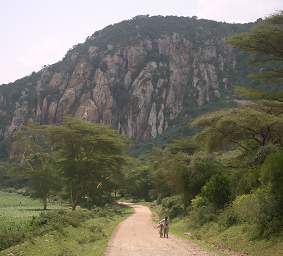 |
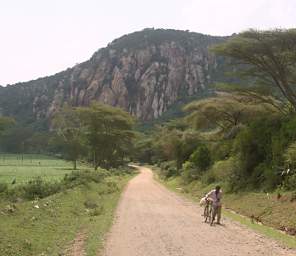 |
 |
| Seeds To Oil Extraction | Seeds To Oil Extraction | Cliff |
We learned in Arusha and Tarangire that virtually every tree and shrub in east Africa is covered in thorns of one kind or another. Some were short, some were long, but all of them made messing around with plants an interesting proposition. It's a defensive mechanism that plants have evolved to help them survive -- the thorns allow them to keep a little more of their leaves than they would otherwise, and that allows them to keep photosynthesizing. The animals have then evolved as well, and it is amazing to watch a large animal like a giraffe wiggle its nose in amongst the thorns to munch on the leaves. But it can't get them all, and so the plant survives, and the arms race continues. Some birds have found a use for the thorns -- the shrikes impale their prey on the thorns, in effect using the thorns as a third hand / foot to hold their meal while they eat it. It makes tearing a largish piece of meat apart easier.
 |
| Acacia Thorns |
Our lunch stop was on the edge of a huge pasture-like area, a communal grazing land. I don't know anything about east African grasses and how it responds to grazing pressure; particularly constant pressure, year after year. I do know that at home our pastures thrive if we
These pastures / grasslands were grazed constantly, at every opportunity, and the grass never gets a chance to rest and recover. I spent a lot of time thinking about the need to introduce people to better grazing practices. But where and how to start? And in order for it to be worthwhile, one needs to also teach people about limits -- limits on the number of cows, and limits on the number of people. Otherwise the cup just fills up to overflowing again and you are back where you started, with even less room to maneuver.
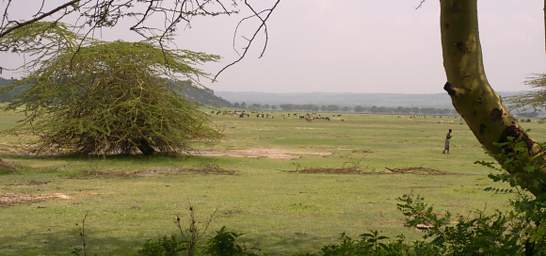 |
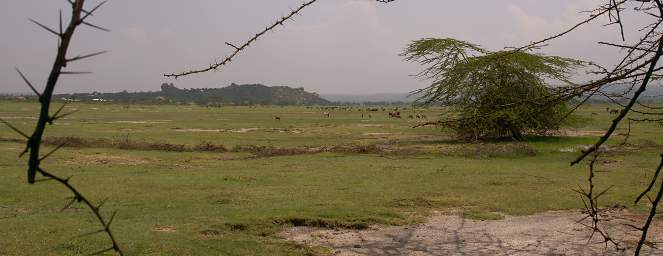 |
| Community Grazing |
As we looked up from our picnic blanket, we could see the local kids who were in charge of their cattle sneaking glances towards us. As Dona said, we are "Wazungu" -- white people -- foreigners -- tourists.
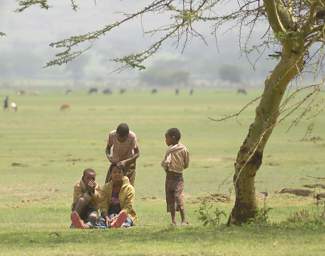 |
| Locals looking the Wazungu over |
We weren't hungry enough to eat all of our boxed lunch, so Dona went over to offer some of what was left to the locals. They went for the pudding and cake but not the hard-boiled eggs. They weren't too awfully hungry, always a good sign. I think mostly they probably wanted to get a good look at those funny-looking white people.
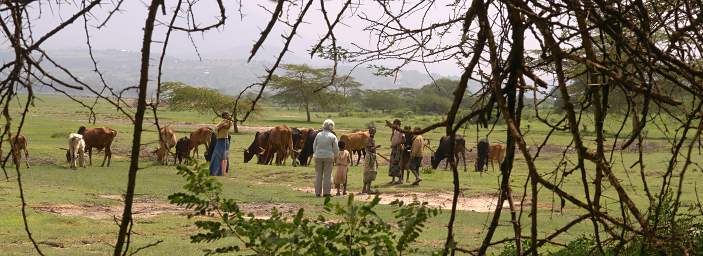 |
| Dona with Locals |
As we were driving along we asked Douglas how he came to work for Dorobo, and how he became such a good birder. He explained to us that guides in Tanzania take a six month course specifically oriented toward the guiding business, where they learn a lot of broad-brush things about the natural history and history of Tanzania. They learn about ecology, mammals, birds, reptiles, climate, geology, and the different environments. At the end of that course they get their guiding certificate; in order to pass, they must be able to identify 350 species of birds. Graduates of the regular guiding school may go on for another year and a half to specialize. While still in basic guide school Douglas was introduced to the owners of Dorobo, the Peterson brothers. Daudi (David) Peterson encouraged him and took him on a "trial" safari, which he passed with what's probably best described as better-than-flying colors. I think he considered immediately going to work for them, but Daudi encouraged him to continue on in guide school, which he did, specializing in ecology. At the end of that, he could identify somewhere over 600 birds. I don't even know that many, let alone identify them. After that he began working for Dorobo. We're delighted to have hooked up with him and them.
Before heading up the escarpment, we stopped to look for birds at Lake Balangida.
 |
| Herding Goats near Lake Balangida |
 |
| Lake Balangida |
 |
 |
| Flower Xxx Lavender | Flower Xxx Yellow
Photo by Dona |
 |
 |
 |
| Photo by Dona | ||
| Flower Xxx Red Yellow | ||
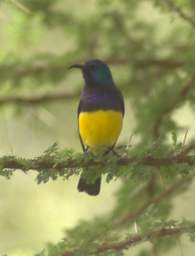 |
| Variable Sunbird |
 |
| Lake Balangida |
Then we headed up the escarpment. We were headed up to about 2000 meters elevation, so we had a lot of going up to do. All of a sudden Douglas pulled over and stopped, saying "Chameleon!" Man, does that guy have eyeballs! He had spotted a Flap-Necked Chameleon on a bush by the side of the road. I had trouble seeing it even when I was standing still right next to the plant.
 |
| Dona checking out a Chameleon
See it? Yeah, I know. Bummer. Me neither. Now imagine spotting that from a moving vehicle. You rock, Douglas! |
 |
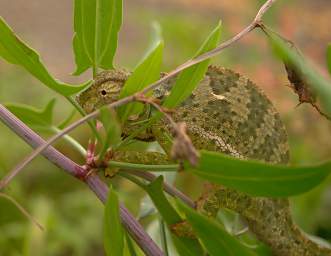 |
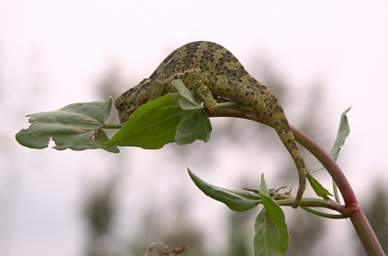 |
| Flap Necked Chameleon | ||
We kept going up and up. We passed many small farms carved out of the hillsides, often with exposed patches of the red clay soil starkly visible. We frequently saw kilns where the clay soil was being made into bricks, a common building block for obvious reasons. It was nice to see local building materials being made and used, as opposed to expensive petroleum-based products being imported.
 |
 |
| Bricks | Buildings |
We continued our way upwards, our path gradually shrinking in width and quality with every fork. There were no signs; you just had to know where you were going. Gradually the farms fell behind us, and the forest closed in. Eventually we came to a big opening on a ridge, and there was our camp.
Waiting for us at camp were two other Dorobo guys, Ole Maria and Lomnyaki; and two local men, Karoli Wema and Andrea. The Dorobo guys had gone ahead to set up camp; Lomnyaki was also our cook. Yum! Good job, Lomnyaki! Karoli and Andrea would be showing us around and explaining the local culture and environment. They were of the Iraqw people, and lived in a village lower down the mountains. Their people have farms in the lowlands, and some seasonally graze farther up near where we were. Dorobo is working with these people to help them get eco-tourism income to try and reduce grazing pressure and preserve and regenerate the forest, which is valuable wildlife habitat for elephants, leopards, and many others.
 |
 |
| Camp | Mess Tent |
Dona and my tent was tucked into the forest for privacy. We had nice cots to sleep on. Dona was feeling a little under the weather and crashed for a bit, while I wandered around exploring.
 |
 |
| Tent | Dona In Tent |
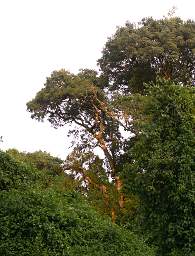 |
| Tree |
The weather wasn't ideal -- cloudy and a bit of a drizzle at times. But that is why the forest is here. We headed off draped in rain gear the next morning, following Karoli.
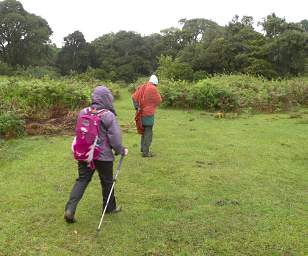 |
 |
| Setting Out | Dona, Karoli and Douglas |
One of the first things we came upon were places where elephants had been tearing up the shrubs. I thought this was a great sign, as I hoped we would get to see some elephants in the forest. One of the other things we found in abundance were holes dug by aardvarks. Apparently they can dig them lickity-split, and use them for shelter.
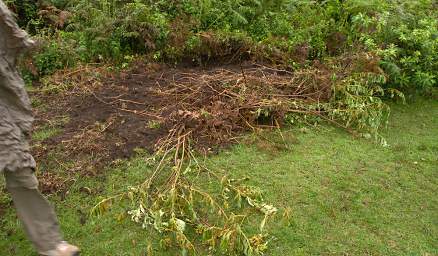 |
 |
| Elephant Damage | Aardvark Hole |
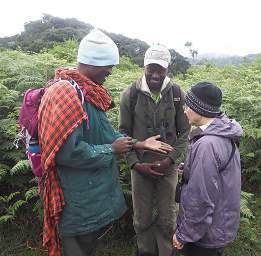 |
 |
 |
| Karoli explaining something to Dona; Douglas interpreting | ||
 |
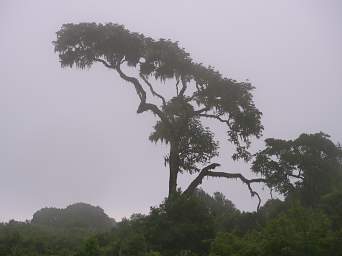 |
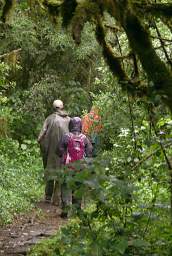 |
We found a pretty good-sized tree enmeshed by a strangler fig, but it wasn't dead ... yet.
 |
 |
| Strangler Fig | |
Karoli pointed out a medicinal plant to us which he explained was used to cure you if you somehow became overcome by evil spirits. I asked him how the cure was done, so he demonstrated on Dona.
 |
| Karoli Curing Dona |
There were large clearings throughout the forest, often on higher ridges. They were grazed pretty heavily, and then large ferns and other less palatable plants began taking over. Karoli explained that when the lowland grasses dried up, people began moving their cows up on the mountain, something they were not supposed to do. During our hikes we would occasionally come upon someone herding their cows. They would often run away so as not to be caught. They would leave the few possessions they had with them by the fire they had going. We found several pairs of shoes and numerous umbrellas.
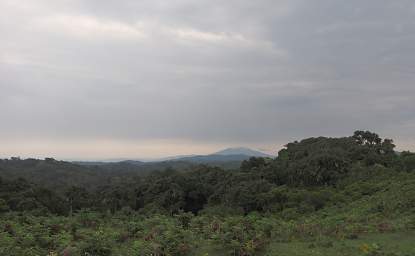 |
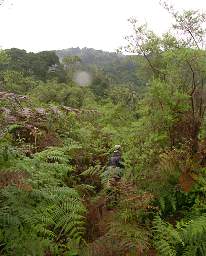 |
 |
| Photo by Dona | Dona |
We didn't see as many birds as we had hoped for, but we did see quite a few pretty flowers; none of which we could properly identify.
 |
 |
| Flower Xxx Blue
Photo by Dona |
Flower Xxx Pink
Photo by Dona |
 |
 |
 |
| Flower Xxx Yellow
Photo by Dona |
Flower Xxx Yellow
Photo by Dona |
Flower Xxx Yellow
Photo by Dona |
 |
 |
 |
| Flower Xxx Yellow
Photo by Dona |
Flower Xxx Orange
Photo by Dona |
Flower Xxx Yellow
Photo by Dona |
 |
 |
| Flower Xxx Lavender
Photo by Dona |
Flower Xxx White
Photo by Dona |
 |
 |
| Flower Xxx White
Photo by Dona |
Flower Xxx Purple |
And a good number of army ants.
 |
| Army Ants |
The birds we did find were pretty cool -- a Lanner Falcon, a Negro Finch, a White-Starred Robin, and a Pin-tailed Wydah.
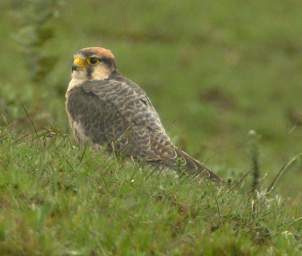 |
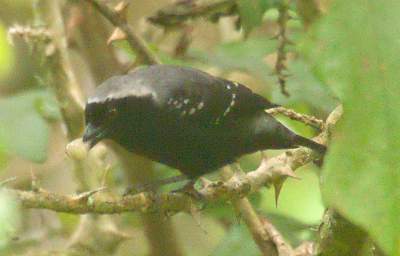 |
| Lanner Falcon | Grey Headed Negrofinch |
 |
 |
| White Starred Robin | Pin Tailed Whydah |
 |
| Butterfly Xxx |
 |
| Tree Flower Xxx Orange |
At one point we came to a large meadow with a small pond at its center. We spent some time looking for birds around the margins, chasing a pin-tailed wydah trying to get a picture. While all this was going on, Karoli sat down, wrapped himself in his robe, and watched.
 |
| Karoli |
There was always a pot of coffee warming on the fire at camp. It was ready when we got up in the morning, and it would be there when we got back from a hike, damp and a bit chilly.
 |
| Morning Coffee |
On our last day we had the option of riding down in the Land Rover or hiking down with Karoli. We opted to hike down. Ole Maria and Lomnyaki broke camp and drove the vehicles down, leaving one parked for us.
 |
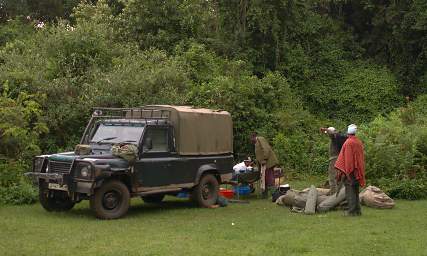 |
| Camp | Support Vehicle |
We were hoping to see more birds, but again didn't see too many. But the hike was great and we much preferred hiking to riding. We had some nice views in spite of the weather. I don't think Karoli really understood the birding aspect of this. We would all stop, grab our binoculars, and start staring or scanning, and he would stand there looking a bit bored. He did get into it a bit more after a while. Maybe the birds were just such an every day part of life for him that they didn't seem like anything special; or maybe he just wasn't particularly interested in them.
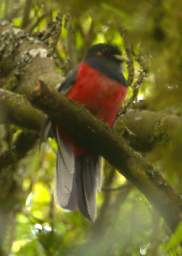 |
| Bar Tailed Trogon |
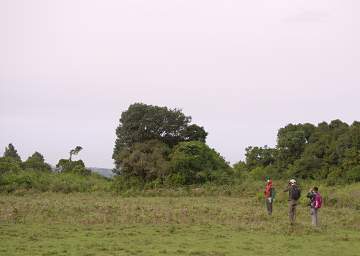 |
 |
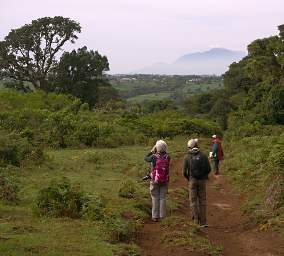 |
| Birding | Hiking
Oldonyo Hanang in background; 4th highest in Tanzania (3418m) |
Birding |
Sometimes we would come upon a small clearing where someone was living, and they would have a few cows that they kept close to home. They would go out and harvest grass and carry it back to feed them, instead of taking the cows out to illegally graze.
 |
 |
| Cattle Herder | Cows Fed |
 |
 |
| Photo by Dona | |
| Blue Monkey | |
As we got lower and closer to the village, we would run into younger children our herding goats. They were usually very shy, and would often run away. If their mother was along, they would hide behind her. One kid had made some small piles of sticks and rocks in the trail; it was not at all clear to me what that was about.
 |
 |
 |
| Kids | Goat | Kid with piles of Rocks and Sticks |
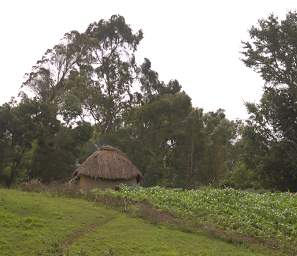 |
| House with Field |
It seemed like everywhere we went there was quite a bit of erosion. It also seemed like the soil was pretty deep, and almost exclusively clay. Rocks seemed to be in short supply. If we could figure out the transportation problem, I could do some good trading with these folks, since we are long on rocks and short on soil.
 |
 |
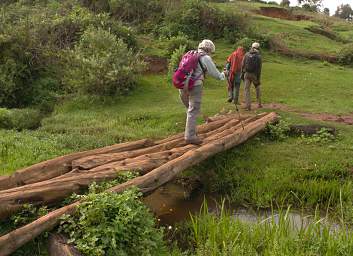 |
| Local Man | Hiking Down | Crossing Bridge |
We came upon a new house being constructed, a place where a farmer was encroaching on the forest preserve. It is a problem in much of Tanzania, wherever there are parks.
 |
| New House Encroaching on Nou Forest Reserve |
 |
 |
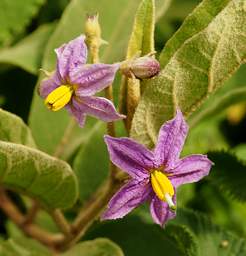 |
| Flower Xxx White
Photo by Dona |
Farms
Photo by Dona |
Flower Lavender Yellow
Photo by Dona |
When we got down into the village and were walking along a hedgerow, Douglas again found us a chameleon... or two... or three... or a bunch! They were all over the place, and boy were they ever cool looking. I particularly liked their paws, which looked much like human hands inside mittens.
 |
 |
 |
| Xxx Chameleon | Xxx Chameleon | Xxx Chameleon |
 |
 |
| Xxx Chameleon | Xxx Chameleon |
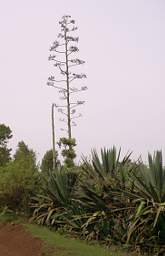 |
| Sisal |
 |
 |
| Nou Forest Farm, Fieldwork | Nou Forest Farms |
Douglas had a great pair of sandals which were a fairly common thing; they are made from the tire of a motorcycle, which is just about the right width for a large person's foot. Similar to what we called "Ho-Chi-Min Sandals" back in the sixties, but these seemed to fit better and be a bit better made. They looked pretty comfortable; but I already had a pair of sandals with me.
 |
| Tire Sandals |
 |
| Church |
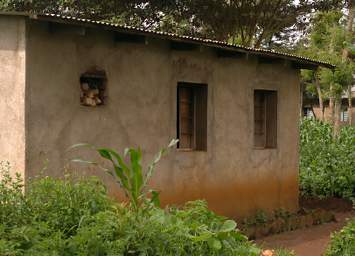 |
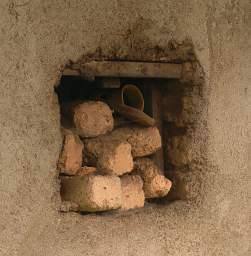 |
| Window Storage | Window Storage |
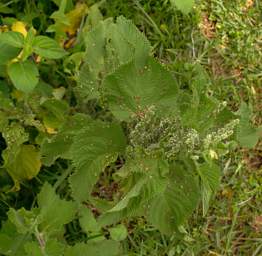 |
| Nettle |
One of the coolest things we came across was some fog nets. These were erected in an area where they got a lot of exposure to fog coming up the mountain, and are designed so the fog condenses on the netting and the water droplets then run down into a storage cistern. It is a community water supply, and people were busily making use of it. Dona had read about them before but we had never seen any real ones.
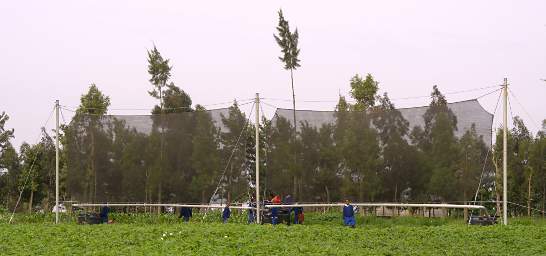 |
 |
| Photo by Dona | |
| Fog Net | |
And then there were more chameleons...
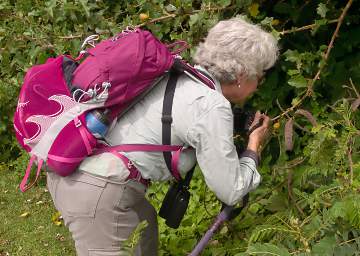 |
| Ok kiddos, where's the Chameleon? |
 |
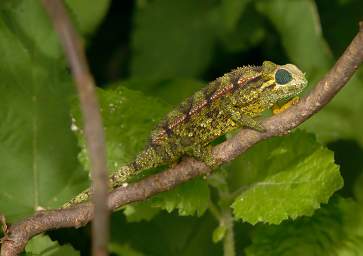 |
| Flap Necked Chameleon | Xxx Chameleon |
 |
| Xxx Chameleon |
 |
 |
| Cows Penned | Boy Goat Herder |
Wherever we saw a house, we usually saw a hole nearby. The hole is where clay was dug up to make bricks for the building.
 |
| House Material Hole |
After a while we came to a house which belonged to a friend of Karoli's, and we were invited inside to see how the people lived here. It was a low building, partly dug into the ground, with a sod / moss / lichen roof on top of a framework of poles. Karoli's friend and Karoli were a little surprised when Dona told them that living roofs similar to theirs were now being used on modern buildings all over the world. As you can see in the photos below, their lawn was kept properly mowed.
 |
 |
| Iraqw Boy and Mom
Photo by Dona |
Iraqw House |
 |
 |
| Iraqw House | Karoli, Douglas and Kids by Iraqw House |
Inside. no space was wasted. There were bunks packed into one side of the building, with the other side serving as animal shelter for pigs, goats, and chickens.
 |
| Iraqw Sleeping Quarters |
There were various animal parts used in traditional healing ceremonies hanging from the ceiling. As Karoli explained it, the animal parts are used in a healing ceremony, then hung in the house to keep the good medicine around. There was also a large rock sitting on the floor, which Karoli said was a mortar; with another smaller rock on top which was the pestle. Karoli also showed us a stir stick used when making soup or porridge.
 |
 |
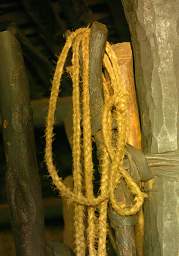 |
 |
 |
| Traditional Medicine Animal Parts | Sisal Halter | Mortar | Stir Stick | |
 |
| Iraqw House |
 |
| Friendly Iraqw |
We came to some houses which Karoli said were build by some guy from the local village who became a bit of a muckity-muck in the government, and apparently he siphoned off some funds to build all these houses for his family. I think he then got fired or fell out of favor or got unelected or something like that, and couldn't finish the houses or could no longer really afford them, and was now trying to rent them out. Or something vaguely along those lines...
 |
| Iraw Houses and Fields |
And more chameleons! Cool!
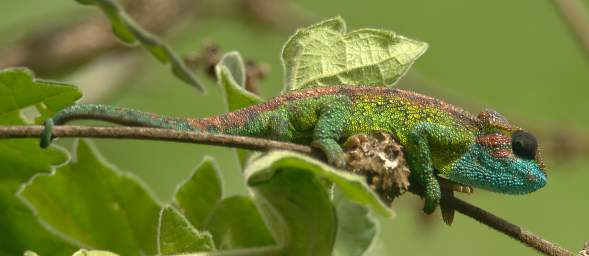 |
| Xxx Chameleon |
We found a couple of big blobs of milkweek bugs, and some other cool-looking beetle.
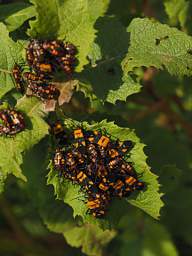 |
 |
 |
| Milkweed Bugs
Photo by Dona |
Milkweed Bug | Some other cool looking Beetle
Photo by Dona |
The Iraqw do a lot of companion planting, in this case beans in with corn.
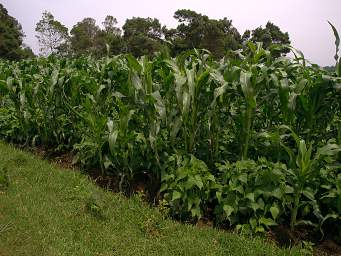 |
| Companion Planting Corn Beans |
When we got to the Land Rover, it was labelled for us. Just in case we didn't recognize it... or to let the locals no it belonged to "good people" and it was ok to be there.
 |
| Dorobo Safaris |
We piled in, filled up on water, and headed to our next spot. As we headed out, we met all the kids returning home from school. As kids everywhere seem to do, they were happy and waved to us.
 |
| School Kids |
 |
| School Kids |
We were headed to the Yaeda Valley, where we would be spending some time with the Hadza hunter-gatherers. I didn't know what to expect, and to be honest, wasn't especially excited. I wasn't un-excited; I just wasn't particularly excited. Ha! Little did I know what we had coming...